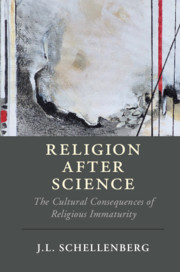Book contents
- Religion After Science
- Cambridge Studies in Religion, Philosophy, and Society
- Religion After Science
- Copyright page
- Dedication
- Contents
- Acknowledgments
- Prologue: The 10,000-Year Test
- 1 Development and the Divine
- 2 The End Is Not Near
- 3 Big Ambitions
- 4 A Poor Record
- 5 Verdict: Immature, Not Doomed
- 6 A New Path for Science and Religion
- 7 The New Agnosticism
- 8 Naturalism Tamed
- 9 Agnostic Religion?
- 10 The New Humanism
- Epilogue: The Religion Project
- Notes
- Index
1 - Development and the Divine
Published online by Cambridge University Press: 09 August 2019
- Religion After Science
- Cambridge Studies in Religion, Philosophy, and Society
- Religion After Science
- Copyright page
- Dedication
- Contents
- Acknowledgments
- Prologue: The 10,000-Year Test
- 1 Development and the Divine
- 2 The End Is Not Near
- 3 Big Ambitions
- 4 A Poor Record
- 5 Verdict: Immature, Not Doomed
- 6 A New Path for Science and Religion
- 7 The New Agnosticism
- 8 Naturalism Tamed
- 9 Agnostic Religion?
- 10 The New Humanism
- Epilogue: The Religion Project
- Notes
- Index
Summary
It’s interesting to think about how ideas we take for granted haven’t always been lodged in someone’s head. They were once in no one’s head and had to emerge, whether among skinny humans, hulking Neanderthals, the tall but less brainy Homo erectus, or someone even further back in our family tree. Some individual or group had to think of using fire to serve human purposes. That was quite possibly erectus. Somebody dreamed up hafting a stone point onto a wooden shaft. That may have happened as far back as Homo heidelbergensis. And someone thought of the wheel. We humans of course were the first to produce a wheel, but whether we were also the first to think of one is anyone’s guess.
- Type
- Chapter
- Information
- Religion after ScienceThe Cultural Consequences of Religious Immaturity, pp. 7 - 18Publisher: Cambridge University PressPrint publication year: 2019

